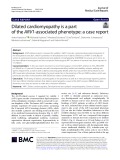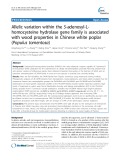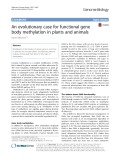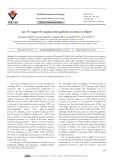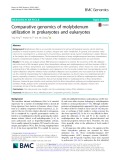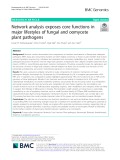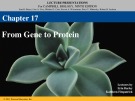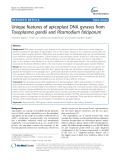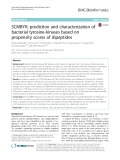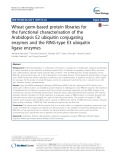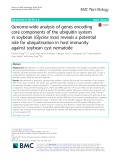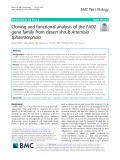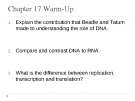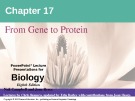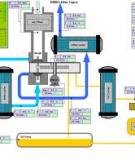
Eukaryotic enzyme
-
ACAT-related enzyme 2 required for viability 1 (ARV1) encodes a transmembrane lipid transporter of the endoplasmic reticulum, which is presented in all eukaryotes and in plants. Deficiency of ARV1 is clinically presented as autosomal recessive developmental and epileptic encephalopathy 38 (DEE38) in humans and in mice.
 5p
5p  vitiki
vitiki
 30-01-2024
30-01-2024
 5
5
 2
2
 Download
Download
-
S-adenosyl-l-homocysteine hydrolase (SAHH) is the only eukaryotic enzyme capable of S-adenosyl-lhomocysteine (SAH) catabolism for the maintenance of cellular transmethylation potential. Recently, biochemical and genetic studies in herbaceous species have obtained important discoveries in the function of SAHH, and an extensive characterization of SAHH family in even one tree species is essential, but currently lacking.
 15p
15p  vinarcissa
vinarcissa
 21-03-2023
21-03-2023
 1
1
 1
1
 Download
Download
-
Proteases represent one of the most abundant classes of enzymes in eukaryotes and are known to play key roles in many biological processes in plants. However, little is known about their functions in fruit ripening and disease resistance, which are unique to flowering plants and required for seed maturation and dispersal.
 23p
23p  vialfrednobel
vialfrednobel
 29-01-2022
29-01-2022
 11
11
 0
0
 Download
Download
-
Cytosine methylation is a covalent modification of DNA that is shared by plants, animals, and other eukaryotes [1]. The most frequently methylated sequences in plant genomes are symmetrical CG dinucleotides, and this methylation is maintained across cell divisions by the MET1 family of methyltransferases.
 3p
3p  vialfrednobel
vialfrednobel
 29-01-2022
29-01-2022
 15
15
 0
0
 Download
Download
-
We investigated the effect of endoplasmic reticulum (ER) protein 29 (ERp29) on thyroglobulin (Tg) secretion and its negative regulation by microRNAs (miRNAs). ERp29 overexpression promoted Tg secretion from thyrocytes of PCCL3 cells via activation of ER stress sensors, including activation of transcription factor 6 fragmentation, XBP1 mRNA splicing by inositol-requiring enzyme 1, and phosphorylation of eukaryotic initiation factor 2 alpha as downstream actions of RNA-dependent protein kinase-like ER kinase.
 6p
6p  dolomite36
dolomite36
 30-12-2021
30-12-2021
 8
8
 0
0
 Download
Download
-
In line with this, when we analyzed the amino acid sequence of E2F1, we found 3 hypothetical consensus PKA phosphorylation sites located at 127-130, 232-235, and 361-364 positions and RYET, RLLS, and RMGS sequences. After showing the binding and phosphorylation of E2F1 by PKA, we converted the codons of Threonine-130, Serine-235, and Serine-364 to Alanine and Glutamic acid codons on the eukaryotic E2F1 expression vector we had previously created.
 18p
18p  thiencuuchu
thiencuuchu
 27-11-2021
27-11-2021
 8
8
 1
1
 Download
Download
-
Molybdenum (Mo) is an essential micronutrient for almost all biological systems, which holds key positions in several enzymes involved in carbon, nitrogen and sulfur metabolism. In general, this transition metal needs to be coordinated to a unique pterin, thus forming a prosthetic group named molybdenum cofactor (Moco) at the catalytic sites of molybdoenzymes.
 14p
14p  vitzuyu2711
vitzuyu2711
 29-09-2021
29-09-2021
 9
9
 1
1
 Download
Download
-
Genomic studies demonstrate that components of virulence mechanisms in filamentous eukaryotic pathogens (FEPs, fungi and oomycetes) of plants are often highly conserved, or found in gene families that include secreted hydrolytic enzymes (e.g., cellulases and proteases) and secondary metabolites (e.g., toxins), central to the pathogenicity process.
 15p
15p  viansan2711
viansan2711
 30-07-2021
30-07-2021
 10
10
 1
1
 Download
Download
-
This chapter describe the contributions made by Garrod, Beadle, and Tatum to our understanding of the relationship between genes and enzymes; briefly explain how information flows from gene to protein; compare transcription and translation in bacteria and eukaryotes; explain what it means to say that the genetic code is redundant and unambiguous;...
 97p
97p  tradaviahe14
tradaviahe14
 27-01-2021
27-01-2021
 12
12
 2
2
 Download
Download
-
DNA gyrase, an enzyme once thought to be unique to bacteria, is also found in some eukaryotic plastids including the apicoplast of Apicomplexa such as Plasmodium falciparum and Toxoplasma gondii which are important disease-causing organisms.
 15p
15p  vikentucky2711
vikentucky2711
 26-11-2020
26-11-2020
 16
16
 1
1
 Download
Download
-
Bacterial tyrosine-kinases (BY-kinases), which play an important role in numerous cellular processes, are characterized as a separate class of enzymes and share no structural similarity with their eukaryotic counterparts. However, in silico methods for predicting BY-kinases have not been developed yet.
 15p
15p  vioklahoma2711
vioklahoma2711
 19-11-2020
19-11-2020
 10
10
 0
0
 Download
Download
-
Protein ubiquitination is a ubiquitous mechanism in eukaryotes. In Arabidopsis, ubiquitin modification is mainly mediated by two ubiquitin activating enzymes (E1s), 37 ubiquitin conjugating enzymes (E2s), and more than 1300 predicted ubiquitin ligase enzymes (E3s), of which ~470 are RING-type E3s.
 15p
15p  vihashirama2711
vihashirama2711
 21-05-2020
21-05-2020
 10
10
 0
0
 Download
Download
-
Ubiquitination is a major post-translational protein modification that regulates essentially all cellular and physiological pathways in eukaryotes. The ubiquitination process typically involves three distinct classes of enzymes, ubiquitin-activating enzyme (E1), ubiquitin-conjugating enzyme (E2) and ubiquitin ligase (E3).
 20p
20p  vichoji2711
vichoji2711
 29-04-2020
29-04-2020
 8
8
 1
1
 Download
Download
-
Linoleic acid is an important polyunsaturated fatty acid, required for all eukaryotes. Microsomal delta12 (Δ12) oleate desaturase (FAD2) is a key enzyme for linoleic acid biosynthesis.
 13p
13p  viharuno2711
viharuno2711
 21-04-2020
21-04-2020
 5
5
 1
1
 Download
Download
-
This chapter describe the contributions made by Garrod, Beadle, and Tatum to our understanding of the relationship between genes and enzymes; briefly explain how information flows from gene to protein; compare transcription and translation in bacteria and eukaryotes; explain what it means to say that the genetic code is redundant and unambiguous.
 64p
64p  nomoney10
nomoney10
 04-05-2017
04-05-2017
 25
25
 3
3
 Download
Download
-
After completing this chapter, students will be able to: Describe the natural function of restriction enzymes and explain how they are used in recombinant DNA technology; outline the procedures for cloning a eukaryotic gene in a bacterial plasmid; define and distinguish between genomic libraries using plasmids, phages, and cDNA;...
 42p
42p  nomoney10
nomoney10
 04-05-2017
04-05-2017
 28
28
 3
3
 Download
Download
-
Chapter 20 introduce to biotechnology. After completing this chapter, students will be able to: Describe the natural function of restriction enzymes and explain how they are used in recombinant DNA technology; outline the procedures for cloning a eukaryotic gene in a bacterial plasmid; define and distinguish between genomic libraries using plasmids, phages, and cDNA; describe the polymerase chain reaction (PCR) and explain the advantages and limitations of this procedure;...
 61p
61p  tangtuy02
tangtuy02
 08-03-2016
08-03-2016
 37
37
 2
2
 Download
Download
-
Chapter 17 - From gene to protein. This chapter describe the contributions made by Garrod, Beadle, and Tatum to our understanding of the relationship between genes and enzymes; briefly explain how information flows from gene to protein; compare transcription and translation in bacteria and eukaryotes; explain what it means to say that the genetic code is redundant and unambiguous;...
 74p
74p  tangtuy02
tangtuy02
 08-03-2016
08-03-2016
 35
35
 1
1
 Download
Download
-
Cấu trúc của gene 1. Các intron và exon Cấu trúc intron và exon của gene là một đặc điểm để phân biệt giữa ADN của sinh vật eukaryote và prokaryote. Các intron chiếm phần lớn trong cấu trúc hầu hết các gene của cơ thể eukaryote. Các đoạn intron này sẽ được các enzyme cắt một cách chính xác ra khỏi các phân tử mRNA trước khi chúng đi ra khỏi nhân tế bào. Vị trí cắt của các enzyme được xác định bởi các đoạn ADN được gọi là các đoạn đồng nhất (consensus sequences) (đoạn này có tên như...
 4p
4p  butmauvang
butmauvang
 29-08-2013
29-08-2013
 175
175
 5
5
 Download
Download
-
Lipases (triacylglycerol acylhydrolases, E.C. 3.1.1.3) are ubiquitous enzymes of consid- erable physiological significance and industrial potential. Lipases catalyze the hydrolysis of triacylglycerols to glycerol and free fatty acids. In contrast to esterases, lipases are activated only when adsorbed to an oil–water interface (Martinelle et al., 1995) and do not hydrolyze dissolved substrates in the bulk fluid. A true lipase will split emulsified esters of glycerine and long-chain fatty acids such as triolein and tripalmitin. Lipases are serine hydrolases.
 76p
76p  loixinloi
loixinloi
 08-05-2013
08-05-2013
 49
49
 9
9
 Download
Download
CHỦ ĐỀ BẠN MUỐN TÌM








